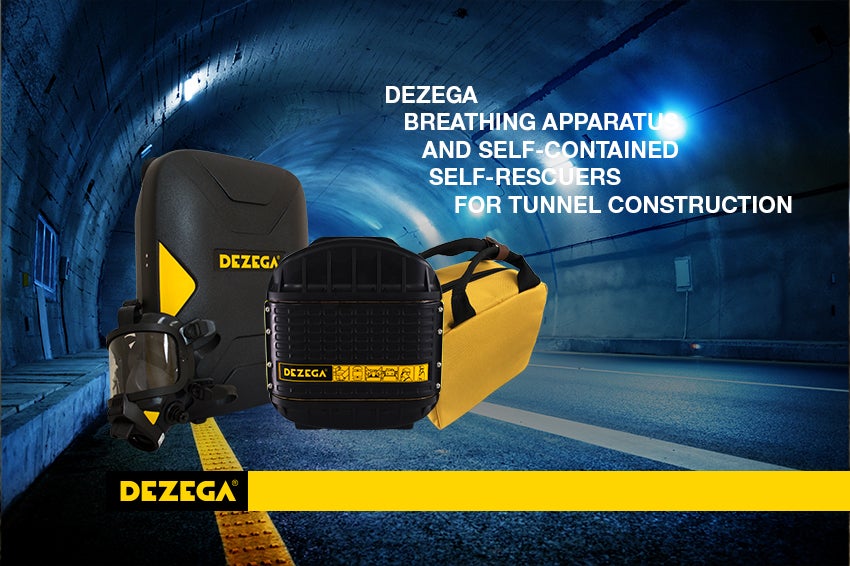
The construction of tunnels and underground structures as well as communications presents not only high technological standards but also significant risks for workers. Ensuring their safety is a priority, with the use of DEZEGA respiratory protection equipment and proper training being of crucial importance.
Tunnel construction, underground structures, and communications are known for their complexity and the need for high technological standards, requiring significant knowledge and resources. These engineering structures play a key role in the modern world, providing access to underground resources, and developing transport networks, communications, and safety in high-risk areas.
The number of tunnels worldwide is rapidly increasing. According to the International Tunnelling and Underground Space Association (ITA), plans are underway to build over 300 major tunnels in the coming years, with another 200 in the construction phase. Thanks to advanced technologies, these tunnels are becoming significantly larger and longer, indicating their increasing scale. Consequently, the risk of accidents such as fires, collapses, flooding, and others is increasing, and this can lead to the formation of atmospheres Immediately Dangerous to Health and Life (IDHL).
The proper selection of respiratory protective equipment for evacuating workers in case of emergencies can save lives. This is confirmed by an incident that occurred in one of the largest projects in Europe, during which several workers successfully evacuated from an unbreathable atmosphere caused by fire, using 60-minute self-contained self-rescuers by DEZEGA.
It is known that to ensure the safety of workers in case of emergencies, it is necessary to carefully calculate potential scenarios and develop effective evacuation routes. Therefore, potential accident scenarios were carefully studied, evacuation routes were developed, and risks of the formation of atmospheres unsuitable for breathing were assessed. Based on these studies, self-contained self-rescuers (SCSR) with a long rated duration time were selected. This allowed workers to successfully evacuate in case of emergencies.
The choice of SCSRs is proved to be optimal, as they completely isolates the respiratory organs from the surrounding environment. Their protective duration time while waiting for rescue lasts three times longer than during evacuation and does not depend on the concentration of hazardous gases and presence of the oxygen in the air.
In addition to the correct choice of SCSR, it is extremely important to train workers on the rules of its use and donning procedure. This will ensure that in case of an emergency, actions for donning the SCSR become intuitive for them.
In the selection of appropriate SCSRs and the calculation of their rated duration time, the availability of appropriate respiratory protective and rescue equipment in rescue services becomes no less important. For example, due to the considerable length of some tunnels and significant distances between emergency exits, a situation may arise where the duration time of a compressed air breathing apparatus (CABA) turns out to be insufficient to reach the place of the accident, carry out rescue operations, or evacuate the injured and reach the safe place.
To increase the duration time, rescue services use long-duration CABA, which significantly increases the weight that the rescuer must carry and increases the cardiovascular load on the body. In this case, the best choice for rescue services will be the Compressed oxygen self-contained closed-circuit breathing apparatus DEZEGA P-70, which has a rated duration time of 4 hours, with a weight of only 14 kg, compared to a CABA weighing up to 18 kg and has a rated duration time of up to 2 hours.
When using the P-70 breathing apparatus in combination with the emergency escape hood DEZEGA EmSCAPE for rescuers or victims, which weighs only 2.15 kg at has duration time of 30 min, instead of the compressed air EEBD, which weights 4-5 kg and duration time of 10-15 min, the load on the rescuer will be reduced by 27% (16 kg instead of 22 kg), and the duration time will double (270 min instead of 135 min).
In conclusion, ensuring worker safety in tunnel construction requires top-quality equipment like DEZEGA Respiratory Protective Equipment (RPE) and comprehensive training programs. With proper training and reliable equipment, we can enhance safety standards and mitigate risks in tunnel construction projects globally.

